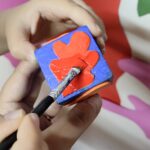Caravaggio’s Diet

He opened his eyes to pitch-black darkness. Panicking, he tried to adjust to the darkness and figure out where he was. His head was throbbing as if someone had struck him from behind, and his heart beat in rhythm with the throbbing in his head. As his eyes and heart adjusted to the darkness, he realized he was in a familiar place. He was behind a cart. As he tried to calm down, he felt that familiar metallic taste in his mouth. “My lip is cut,” he thought. He moved his neck back and forth and tried to make sense of the tangled moments of the night while trying to lift himself on his hands. The only thing he remembered was a dark street, chaos, and an attempt to reach his sword. And then he remembered. He was fleeing. Yes. He was running away again. He was certain that if caught, death would be inevitable. From Rome to Sicily, from Sicily to Malta, his life on the run, whether among rich friends or in a bar corner, had come to a head with an unfortunate fight. Yet, becoming a knight was imminent. As he tried to stand on his hands, his thoughts were interrupted by a voice and a jolt. The cart had stopped. He was frightened as footsteps approached him. His heart started to race faster. Fear had seized his entire body, leaving him breathless. When the man who approached the back of the cart told him to get down, he realized that it was all over. He had been caught.
The man who had fled Rome after being sentenced to death for murder and had lived as a fugitive for years was Michelangelo Merisi da Caravaggio, known as Caravaggio. He had been living in Malta, where he was avoiding trial and continuing to paint, but unfortunately, after attacking and injuring a knight, he had found himself in legal trouble in Malta as well and could not escape the law this time.
Born in Milan in 1571, Caravaggio’s family had fled to the countryside in 1576 to escape the plague that killed his father. Caravaggio took the name of the town he settled in. He started painting at a young age. In 1584, the year he began his apprenticeship under Simone Peterzano, the painter, who had lost his mother at the age of 13, had a dramatic, fearful, and turbulent life, much like the drama, fear, and danger depicted in his simple and theatrical paintings. He was the most notoriously infamous artist in art history, known for his arrogant recklessness, drunken antics, brawls, random sexual encounters, and illegal activities. He would easily lose his temper, frequently get involved in bar and street fights, walk the streets with an unlicensed sword, drill holes in the ceiling of his rented house for more light, and frequently engage in duels. He worked on his paintings with the same intensity and obsession as his drunken street brawls in Rome. His character was reflected in his art, filled with violent scenes, exaggerated light-dark contrasts (chiaroscuro), and dramatic lighting (tenebrism).
In May 1606, amidst this turbulent life, he killed a man named Ranuccio Tomassoni. They had fought over a woman named Fillide Melandroni, and Caravaggio had killed Tomassoni while attempting to castrate him. Whether the cause was a gambling debt or a fierce duel, Caravaggio was found guilty, and the Italian courts issued a death warrant, making him live in fear of death until the day he was captured. In 1608, still wanted for murder in Rome, Caravaggio attacked Fra Giovanni Rodomonte Roero, one of Malta’s senior knights, and was imprisoned. In 1610, while attempting to return to Rome, he died from an infection caused by a wound he sustained in another fight. During his short but intense life, he produced magnificent paintings and left an enduring mark on the art world.
Michelangelo Merisi da Caravaggio was a painter known for his dark and story-filled paintings. His most famous works include religious figures such as “David with the Head of Goliath,” “The Calling of Saint Matthew,” and “The Supper at Emmaus.” Caravaggio worked in a realistic and emotional manner. His works often led to controversy in his time. However, Caravaggio’s paintings came into the spotlight again in 2016 for a different reason. His still lifes were cited by a physician at the Obesity Forum in England as a good example of healthy eating. The physician, who named the suggestions “The Caravaggio Diet,” believed that Caravaggio’s still lifes, filled with healthy foods, provided excellent examples of healthy eating.
The diet was inspired by “The Supper at Emmaus,” painted in 1601. In “The Supper at Emmaus,” there is a table prepared for the risen Christ. Among the many fruit baskets that adorn Caravaggio’s art, one contains only overripe apples, pomegranates, and exceptionally realistic grapes, some even hanging over the edge of the basket. For Caravaggio, fruit was his second favorite subject after young men with red lips and dark eyes who offered fruit. If you truly accept Caravaggio’s still lifes as a recommendation, we would need to eat plenty of fruit.
In fact, “The Supper at Emmaus” was the only meal in Caravaggio’s paintings that was not entirely fruit-based; it also included bread soaked in wine and a well-cooked bird. However, even the poultry was a low-fat food. You won’t find red meat in any of Caravaggio’s paintings. Perhaps using him as a healthy eating guru, as suggested, might make sense.
One of Caravaggio’s most famous paintings is “Bacchus,” which depicts the Greek god of pleasure and wine, Dionysus. It is thought that Caravaggio’s depiction of Bacchus was a self-portrait. In the first Bacchus painting, there is a bowl of fruit and a jug of red wine on a stone table. He raises a goblet with his left hand as if offering it. This appetizing image is not very different from many current healthy eating regimens. The details in the painting are interesting. The fruits in the basket are overly ripe, even rotten and worm-eaten, which, while illustrating the transience of earthly life, also reflect the painter’s honesty with the dirty fingernails, as it is realistic and natural.
In another portrait of Bacchus, he appears more pallid and weary, as if something is consuming him. It is said to be an illness, but there is no information on which illness. At the time, the painter was indeed ill. The rotten fruits from the previous painting are replaced here with healthier and fresher fruits. The painter seems to have intended an irony, depicting fresh and brightly colored fruits.
“The Boy with a Basket of Fruit” was painted when Caravaggio had just arrived in Rome and was not well known in the art world. The boy in the painting was Mario Minniti, a close friend of Caravaggio, who was 16 years old at the time and would later be one of his models many times. Red, black, and white grapes, apples, pears, apricots, figs, pomegranates, and grape, pear, and lemon leaves create a nearly tactile and visual as well as aromatic and sweet, rich fruit bouquet. It seems as if Caravaggio stopped a delivery boy with a fruit basket destined for the knight’s dining room and captured that moment as fresh and crisp as the fruit itself.
So, how wise is it to take dietary advice from a man who died at 38 and even depicted himself as ill in a painting like Bacchus in his twenties? In fact, an interesting note in Caravaggio’s criminal record shows that he certainly paid attention to his food. You read about a waiter who served Caravaggio a plate of artichokes fried half in olive oil and half in butter, and was beaten when Caravaggio asked which part was fried in butter. When the waiter replied, “You can tell by smelling,” Caravaggio jumped up and struck him with an earthenware plate. Perhaps, if not for his friends, he would have drawn his sword, which he always carried, and killed the waiter. Clearly, he was concerned about eating too much butter and paying attention to his health. And the foundations of the Italian/Mediterranean cuisine that Caravaggio preferred trace back to the 16th century. In Renaissance Italy, fruit and salads were fashionable. The writer Pietro Aretino (likely both the inventor of journalism and pornography and a master of satire) praised the refined use of medicinal herbs and particularly Tuscan salads in his writings, and spoke of toasting bread over an open flame and dipping it in olive oil, that is, crostini.
Of course, as a realist painter, Caravaggio was not presenting a diet with his paintings. He did not idealize any event but instead captured the essence of what he saw on the canvas. In fact, in “The Supper at Emmaus,” he had used the rotten fruits as a metaphor within a religious scene. To him, the fruit basket represented sin, illness, and death; everything that the spiritual Christ had come back to save. The cold, dead roasted bird is the image of crucifixion. Ultimately, I don’t think he cared much about food; he was only concerned with sin and death.
In the Bacchus portrait, however, when we look at his face, we see a story of a slightly embarrassed and melancholy look in his sharp eyes. The faint tone on his cheeks indicates he is embarrassed about something. The painting also has an erotic quality. The grapes and vines in the figure’s hair carry meanings of health, love, and beauty. The wine jug also reflects a self-portrait
. The subject of the work is determined by the painter’s tendencies and tastes. The piece is 93×85 cm and is displayed at the Uffizi Gallery in Florence.









